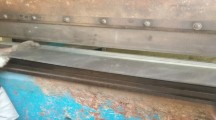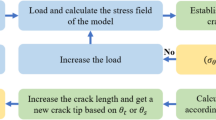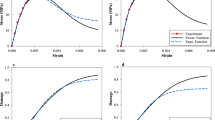Abstract
To evaluate the fracture behavior of steel structures under some severe corrosion environments, experiments on eight artificially pitting corroded Q345 steel plates and numerical investigations on 200 finite element models of randomly pitting damaged steel were conducted. The effects of the distribution, diameter and depth of the corrosion pits on the tensile behavior were investigated and a probability density function of randomly pitting corroded steel strength was developed. The results indicate that both the yield strength and the ultimate strength of steel plates with random pitting corrosion were lower than those of uniformly corroded steels with the same corrosion ratios. The effects of pitting depth on the yield strength and the ultimate strength were more significant than those of pitting diameter. The influences of pitting distribution on ultimate strength were greater than that on yield strength. The residual tensile strength of steel plates with random pitting corrosion was found to well conform to the Gamma distribution, and thus the probability density functions of the residual yield strength and the ultimate strength were proposed based on the Gamma distribution.













Similar content being viewed by others
Abbreviations
- A i :
-
The area of the ith pit (mm2)
- A c :
-
The total area of the pits (mm2)
- V i :
-
The volume of the ith pit (mm3)
- V c :
-
The total volume of the pits (mm3)
- d :
-
The pit depth (mm)
- f y :
-
The nominal yield strength (MPa)
- f u :
-
The nominal ultimate strength (MPa)
- \(f_{{\text{y}}}^{\prime }\) :
-
The residual yield strength (MPa)
- \(f_{{\text{u}}}^{\prime }\) :
-
The residual ultimate strength (MPa)
- δ :
-
The overall deformation of the test zone
- t c :
-
The thickness of coupon
- ε :
-
The strain value
- σ ep :
-
The Von Mises equivalent flow stress
- ε ep :
-
The equivalent plastic strain
- n :
-
The strain hardening exponent
- r i :
-
The radius of the random pit (mm)
- L :
-
The length of corrosion area (mm)
- H :
-
The width of corrosion area (mm)
- \(\overline{r}\) :
-
The average value of pit radius (mm)
- f o :
-
The initial physical characteristic parameters
- A o :
-
The initial geometrical parameters
- R o :
-
The initial strength (MPa)
- R :
-
The strength index (MPa)
- f :
-
The physical performance index
- A :
-
The geometric parameter index
- X :
-
The pit radius in normal distribution (mm)
- Y :
-
The pit depth in normal distribution (mm)
- λ :
-
The proportional parameter in Weibull distribution
- k :
-
The shape parameter in Weibull distribution
- α :
-
The shape parameter in Gamma distribution
- β :
-
The scale parameter in the Gamma distribution
- ξ :
-
The square of pit radius in Lebesgue–Stieltjes integral (mm2)
- η :
-
The pit depth in Lebesgue–Stieltjes integral (mm)
- t :
-
The dependent variable of Gamma distribution
- ρ :
-
The random volume loss ratio
- w :
-
The probability value of strength degradation
- x :
-
The sample of strength degradation (MPa)
- φ :
-
The strength degradation ratio
- φ y :
-
The degradation ratios of the yield strength
- φ u :
-
The degradation ratios of the ultimate strength
References
ABS. (2009). Guide for hull thickness measurement. In Rules for survey after construction. American Bureau of Shipping Houston. https://ww2.eagle.org/content/dam/eagle/rules-and-guides/current/generic/generics-2023/part-7-jan23.pdf
Ahmad, R. R., Nabi, N., & Arvin, Z. (2015). Ultimate strength of stiffened plates with pitting corrosion. International Journal of Naval Architecture and Ocean Engineering, 7(3), 509–525. https://doi.org/10.1515/ijnaoe-2015-0037
Alcántara, J., Chico, B., Díaz, I., Fuente, D., & Morcillo, M. (2015). Airborne chloride deposit and its effect on marine atmospheric corrosion of mild steel. Corrosion Science, 97, 74–88. https://doi.org/10.1016/j.corsci.2015.04.015
Ali, D., Rasool, R., Najmeh, A., & Zohreh, S. (2017). The effect of dependence on distribution of the functions of random variables. Communications in Statistics Theory and Methods, 46(21), 10704–10717. https://doi.org/10.1080/03610926.2016.1242740
Beylkin, G., Monzón, L., & Satkauskas, I. (2019). On computing distributions of products of random variables via Gaussian multiresolution analysis. Applied and Computational Harmonic Analysis, 47(2), 306–337. https://doi.org/10.1016/j.acha.2017.08.008
Daidola, J. C., Parente, J., Orisamolu, I. R., & Ma, K. (1997). Residual strength assessment of pitted plate panels. In Ship Structure Committee Report SSC-394.
Hairil, M. M., & Paik, J. K. (2013). Investigation of the corrosion progress characteristics of offshore subsea oil well tubes. Corrosion Science, 67, 130–141. https://doi.org/10.1016/j.corsci.2012.10.008
Huang, Y., Zhang, Y., Liu, G., & Zhang, Q. (2010). Ultimate strength assessment of hull structural plate with pitting corrosion damnification under biaxial compression. Ocean Engineering, 37, 1503–1512. https://doi.org/10.1016/j.oceaneng.2010.08.001
Johnson, G. R., & Cook, W. H. (1983). A constitutive model and data for metals subjected to large strains high strain rates and high temperature. In Proceedings of the 7th international symposium on ballistics (pp. 541–547). International Ballistics Committee, Netherlands.
Kong, D. L., Nie, B., & Xu, S. H. (2021). Random field model of corroded steel plate surface in neutral salt spray environment. KSCE Journal of Civil Engineering, 25(7), 2651–2661. https://doi.org/10.1007/s12205-021-1249-5
Li, X., Liang, Y. S., Zhao, Z. H., & Lv, H. L. (2015). Low-cycle fatigue behavior of corroded and CFRP-wrapped reinforced concrete columns. Construction and Building Materials, 101, 902–917. https://doi.org/10.1016/j.conbuildmat.2015.10.063
Li, X., Zhao, Z. H., Liang, Y. S., & Lv, H. L. (2016). Cyclic behaviour of earthquake and corrosion-damaged RC columns. Magazine of Concrete Research, 68(22), 1166–1182. https://doi.org/10.1680/jmacr.16.00155
Lin, M. Q., Xu, S. H., & Niu, D. T. (2013). Study on the deterioration properties of corroded steel based on weibull distribution. Applied Mechanics and Materials, 253(1), 390–393. https://doi.org/10.4028/www.scientific.net/AMM.253-255.390
Lin, Y. C., Chen, X. M., & Liu, G. (2010). A modified Johnson-Cook model for tensile behaviors of typical high-strength alloy steel. Materials Science and Engineering A, 527, 6980–6986. https://doi.org/10.1016/j.msea.2010.07.061
Melchers, R. E. (2005). Statistical characterization of pitting corrosion-part2: Probabilistic modeling for maximum pit depth. Corrosion, 61(8), 766–777. https://doi.org/10.5006/1.3278211
Nakai, T., Matsushita, H., Yamamoto, N., & Arai, H. (2004). Effect of pitting corrosion on local strength of hold frames of bulk carriers (1st report). Marine Structures, 17, 403–432. https://doi.org/10.1016/j.marstruc.2004.10.001
National Standards of People’s Republic of China. (2010). GB228.1-2010 Metallic materials—Tensile testing—Part 1: Method of test at room temperature. Beijing: China Standard Press. in Chinese.
Qin, X. X., Gao, G., Zhou, S. L., & Zou, H. X. (2012). Method on parameters estimation of generalized gamma distribution based on scale-independent-shape-estimation (SISE) equation. Journal of Electronics and Information Technology, 34(08), 1860–1865. https://doi.org/10.3724/SP.J.1146.2011.01260
Saulo, H., Bourguignon, M., Zhu, X. J., & Balakrishnan, N. (2019). Some simple estimators for the two-parameter gamma distribution. Communications in Statistics: Simulation and Computation, 48(8), 2425–2437. https://doi.org/10.1080/03610918.2018.1457693
Sheng, J., & Xia, J. W. (2017). Effect of simulated pitting corrosion on the tensile properties of steel. Construction and Building Materials, 131, 90–100. https://doi.org/10.1016/j.conbuildat.2016.11.037
Shi, X. H., Zhang, J., & Guedes, S. C. (2018). Numerical assessment of experiments on the ultimate strength of stiffened panels with pitting corrosion under compression. Thin-Walled Structures, 133, 52–70. https://doi.org/10.1016/j.tws.2018.09.029
Silva, J. E., Garbatov, Y., & Guedes, S. C. (2013). Ultimate strength assessment of rectangular steel plates subjected to a random localised corrosion degradation. Engineering Structures, 52, 295–305. https://doi.org/10.1016/j.engstruct.2013.02.013
Silva, J. E., Garbatov, Y., & Guedes, S. C. (2014). Reliability assessment of a steel plate subjected to distributed and localized corrosion wastage. Engineering Structures, 59, 13–20. https://doi.org/10.1016/j.engstruct.2013.10.018
Sultana, S., Wang, Y., Sobey, A. J., Wharton, J. A., & Shenoi, R. A. (2015). Influence of corrosion on the ultimate compressive strength of steel plates and stiffened panels. Thin-Walled Structures, 96, 95–104. https://doi.org/10.1016/j.tws.2015.08.006
Wang, R. H., & Ajit, S. R. (2019). Experimental and numerical study on ultimate strength of steel tubular members with pitting corrosion damage. Marine Structures, 64, 124–137. https://doi.org/10.1016/j.marstruc.2018.11.006
Wang, R. H., Shenoi, R. A., & Sobey, A. (2018). Ultimate strength assessment of plated steel structures with random pitting corrosion damage. Journal of Constructional Steel Research, 143, 331–342. https://doi.org/10.1016/j.jcsr.2018.01.014
Wang, Y. K., Wharton, J. A., & Shenoi, R. A. (2015). Ultimate strength assessment of steel stiffened plate structures with grooving corrosion damage. Engineering Structures, 94, 29–42. https://doi.org/10.1016/j.engstruct.2015.02.028
Yoichi, N. (2008). Nonparametric estimation and testing time-homogeneity for processes with independent increments. Stochastic Processes and Their Applications, 118(6), 1043–1055. https://doi.org/10.1016/j.spa.2007.07.011
Yu, H. L., & Jeong, D. Y. (2010). Application of a stress triaxiality dependent fracture criterion in the finite element analysis of unnotched Charpy specimens. Theoretical and Applied Fracture Mechanics, 54, 54–62. https://doi.org/10.1016/j.tafmec.2010.06.015
Yuan, F., Chen, M. C., Huang, H., Xie, L., & Wang, C. (2018). Circular concrete filled steel tubular (CFST) columns under cyclic load and acid rain attack: Test simulation. Thin-Walled Structures, 122, 90–101. https://doi.org/10.1016/j.tws.2017.10.005
Zhang, J., Shi, X. H., & Guedes, S. C. (2017a). Experimental analysis of residual ultimate strength of stiffened panels with pitting corrosion under compression. Engineering Structures, 152, 70–86. https://doi.org/10.1016/j.engstruct.2017.08.069
Zhang, Y., Huang, Y., & Wei, Y. (2017b). Ultimate strength experiment of hull structural plate with pitting corrosion damage under unaxial compression. Ocean Engineering, 130, 103–114. https://doi.org/10.1016/j.oceaneng.2016.11.065
Zhao, Z. W., Zhang, H. W., Xian, L. N., & Liu, H. Q. (2020a). Tensile strength of Q345 steel with random pitting corrosion based on numerical analysis. Thin-Walled Structures, 148, 106579. https://doi.org/10.1016/j.tws.2019.106579
Zhao, Z. W., Zhang, N., Wu, J. J., Gao, Y. R., & Sun, Q. W. (2020b). Shear capacity of steel plates with random local corrosion. Construction and Building Materials, 239, 117816. https://doi.org/10.1016/j.conbuildmat.2019.117816
Acknowledgements
This research was supported by the Natural Science Foundation of China (Grant No. 51978656) and Key Research and Development Project of Xuzhou (KC19207). The financial supports are gratefully acknowledged.
Author information
Authors and Affiliations
Corresponding author
Ethics declarations
Conflict of interest
The authors declare that they have no known competing financial interests or personal relationships that could have appeared to influence the work reported in this paper.
Additional information
Publisher's Note
Springer Nature remains neutral with regard to jurisdictional claims in published maps and institutional affiliations.
Rights and permissions
Springer Nature or its licensor (e.g. a society or other partner) holds exclusive rights to this article under a publishing agreement with the author(s) or other rightsholder(s); author self-archiving of the accepted manuscript version of this article is solely governed by the terms of such publishing agreement and applicable law.
About this article
Cite this article
Liao, X., Li, X. & Xu, YM. Probabilistic Tensile Strength Model of Q345 Steel Plates with Random Pitting Corrosion for Fragility Analysis. Int J Steel Struct 23, 548–563 (2023). https://doi.org/10.1007/s13296-023-00709-3
Received:
Accepted:
Published:
Issue Date:
DOI: https://doi.org/10.1007/s13296-023-00709-3




